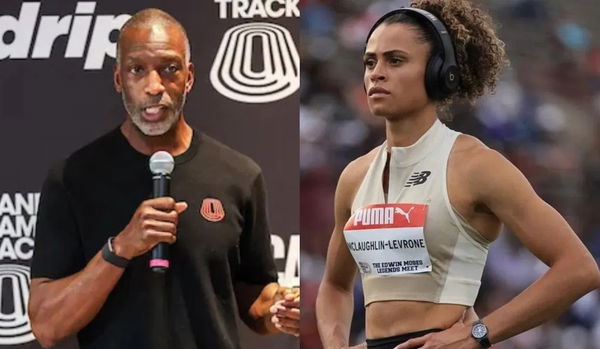
via Imago
Image via IMAGO

via Imago
Image via IMAGO
The momentum of interest track & field received after the Paris Olympics was a welcome development. The sport had faced financial struggles for years and several athletes, from Sha’Carri Richardson to Tara Davis-Woodhall, have been upfront about it. But when Michael Johnson introduced his league, Grand Slam Track, it was thought to be a turnaround. The league promised its athletes $100,000 for the first spot and appearance money in each of its four legs. However, its April debut in Kingston, Jamaica, was already a disappointment, failing to gain the assumed traction.
The league had high hopes, backed by its $30 million in sponsorship money. But Johnson claimed most of it went into improving the sport’s perceived outlook. In his words, “We weren’t trying to make a small change—we were trying to make a bold one.” The participants got first-class plane tickets, separate hotel rooms, and professional-grade broadcast production. But so far, they have only received the Kingston appearance fee. The league is reportedly already in over $13 million of debt, despite cancelling its LA leg. And the sport is, once again, facing the old problems. Calculating it all, the American track and field coach, David E. Robinson, has shed light on the sport’s current state.
In his latest podcast episode, Coach Rob shared his thoughts, “I totally understand that track & field has this real issue that caught us between a rock and a hard place. We have athletes that are incredibly talented, work incredibly hard, and dedicate their lives to the sport. The performances are proof of that. But when you talk about being in the entertainment business, you don’t get paid what you’re worth. You get paid what you negotiate. Do you really get paid off of the value that you can bring back? Sorry.
ADVERTISEMENT
Article continues below this ad
“In track & field right now, it’s really hard for the athletes to provide value that’s commodifiable. Again, a lot of that prize money and things that travel, like in the sport currently, a lot of it really more charity than it is value. I know that sounds offensive, but I’m being real. People are not being paid what they’re worth, they’re being paid whatever they can negotiate. That’s it.
“And we kind of have a world where most of the track and field athletes get almost nothing. It’s the reason why we have unattached athletes who have no sponsors at all, pulling up to the USA and competing and even making finals. These people don’t make money from track & field. They spend money to compete in track & field.”
It is true that most of the athletes do not get paid and are often left to search for a side hustle to keep competing in the sport. The maximum the Diamond League is also ready to go for is double its original prize money to a $20,000 for the winner. Others, however, are still stuck. Although Alexis Ohanian’s Athlos, too, added some relief to the already growing awareness, it wasn’t enough. With no backing, they also cannot negotiate like the major players can in other leagues that make much more money.
ADVERTISEMENT
Article continues below this ad
Sydney McLaughlin-Levrone, however, hasn’t faced that struggle, thanks to her New Balance sponsorship. Still, the Grand Slam Track collapse has made her coach start thinking differently.
Sydney McLaughlin-Levrone’s coach found something hard to believe.
Sydney McLaughlin-Levrone had every reason to stay hopeful about Grand Slam Track. On June 19, the league’s official X account posted her upbeat message. You could feel the optimism as the four-time Olympic champion wasn’t just showing up — she was all in. “I think it’s just bringing so much excitement to the sport,” she said, confident that GST could become a long-term game-changer. “I can see this being something that, in the years to come, people are going to join. It’s just a great opportunity for the sports, for track and the athletes,” she added, painting a picture of a brighter future.
ADVERTISEMENT
Article continues below this ad
What’s your perspective on:
Is the Grand Slam Track a cautionary tale for athletes relying on big promises and little delivery?
Have an interesting take?
But that bright picture faded fast. Her coach, Bobby Kersee, felt the blow when GST crumbled. On June 14, after the LA edition was canceled, he poured his disappointment into a social media post. “Over four decades in this sport, I’ve watched too many promising initiatives fall short due to organizational challenges, particularly from lack of corporate sponsorship,” he wrote. His words mirrored Coach Rob’s.
Still, Kersee didn’t let the frustration kill his faith. Even after the Grand Slam finale was scrapped, he stood by the brand: “Our athletes are world-class. They train hard and deserve better. The Grand Slam brand is still very promising, but today, seasons and careers are impacted.” The reality is here, and it’s harsh. Dreams have been delayed, money’s still missing, and athletes are left hanging. While Johnson claims a 2026 return, is Grand Slam Track a one-hit wonder, or a comeback story waiting to happen?
Top Stories
ADVERTISEMENT
ADVERTISEMENT
ADVERTISEMENT
ADVERTISEMENT



Is the Grand Slam Track a cautionary tale for athletes relying on big promises and little delivery?